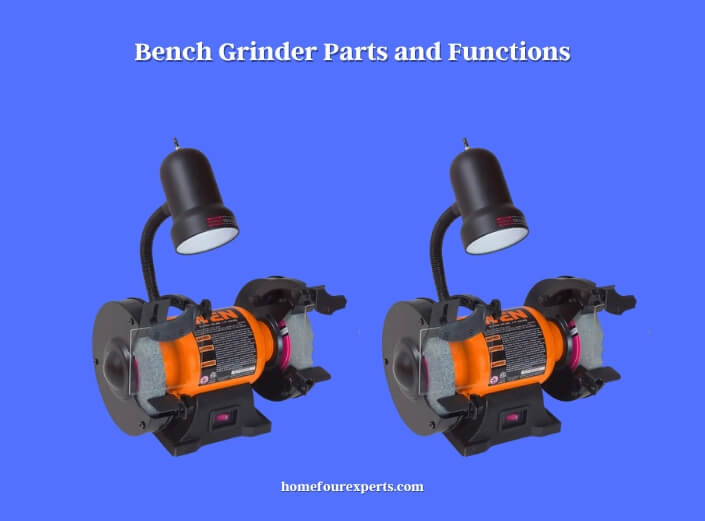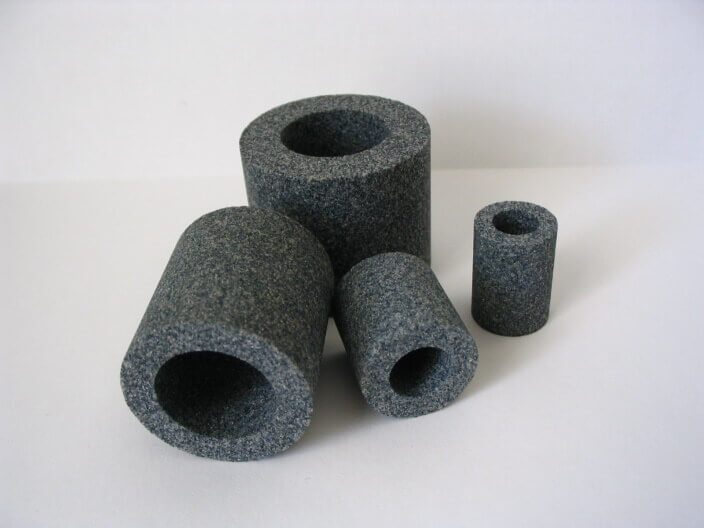Published on: April 25, 2022
Written by David Rowan / Fact-checked by Eric Devin
There are three kinds of grinders, also called grinding machines including bench grinder, surface grinder and cylindrical grinder widely used by the operators. These all are power-run tools. The bench grinder comes with powerful wheels to grind different types of metal and wooden materials. The wheel of this machine is abrasive in nature which is used to perform multi-functions including shaping, sharpening, buffing, polishing, and cleaning, etc.

The different parts of this machine, particularly wheels, play a key role while grinding tasks take place. One of the important aspects of the wheel is RPM or rotating speed per minute that greatly influences the professional grade grinding performance.
It’s named as a bench grinder as it’s usually installed on a bench or table where the workpiece is attached tightly against the grinding wheel to function for specific grinding tasks. There are different types of wheels from 36-grit to 100-grit and even above. Each of them is used to perform specific tasks. For example, 36-grit is good for sharpening the gardening tools, 60-grit works great for chisels and irons. While 80 or 100-grit are recommended for subtle jobs including shaping metal items.
However, with the above note, I have designed this article to discuss the bench grinder parts and functions to give you a basic idea. This key information would help you efficiently deal with your grinding project.
Major Parts of Grinder
Bench grinder consists of five major parts including motor, grinding wheels, wheel guards, eye shield, and tool rest, etc. Each of the parts has a specific function to achieve the higher grade performance. The key purpose of the grinder is to deal with shaping, sharpening, buffing, polishing, and cleaning, etc. However, the function of each part is discussed below.
Motor
The motor is usually assembled in the middle slot of the grinder. Its grinding capacity is determined by its horsepower which dominates the number of revolutions per minute (RPM) of the grinding wheel.
Different types of grinding wheels are attached with the grinder to perform different kinds of grinding jobs. Average speed range of grinding wheels varies from 3000-3600 RPM. The grinder works faster based on its higher revolution per minute, particularly applicable to grinding the harder materials like steel.
Grinding Wheels

Wheel is the main part of the grinding machine which mainly plays the key role. There are different kinds of wheels combining variable power grids available in the market with specific RPM ratings displayed or printed on the cover.
Different grit ranges from 36-grit to 10-grit and above serves the multi-functions including sharpening, buffing, shaping, polishing, and cleaning, etc., to prepare a metal or wooden workpiece. For instance, a 36-grit wheel is good for sharpening gardening tools, 60-grit is ideal for chisels and irons. While 80 or 100-grit are recommended for refined jobs including shaping metal items.
No wheel should exceed the specified RPM recommended by the manufacturer. Else, over speeding wheels may cause explosions leading to severe injuries and damage to project work.
Wheel Guards
This part is attached with the wheel to mainly prevent the flying particles of the exploding wheel towards the operators that might get them injured.
Running grinder usually produces a huge amount of sparks and emits wood particles which are held back by the wheel guard to prevent accidents. The size of the guard is usually large enough to safely cover the wheel keeping the operator’s fingers or other accessories out of the wheel.
Eye Shield
This part is assembled just over the grinding wheel to prevent the crumbs that might hit the operator’s face or eyes and cause injury. However, for extra caution, you are advised to use eye protective goggles while operating your bench grinder.
Tool Rest
Tool rest comes with the bench grinder to hold your working object securely when the grinder is on operation. You need to attach it firmly within 1/16 inches to 1/8 inches of the wheel to protect the workpiece from falling or slipping down. This part also helps hold the workpiece while changing or readjusting the speed of the wheel.
Major Functions of Bench Grinder
As stated earlier, bench grinder is able to perform different kinds of functions efficiently compared to other grinding machines. This machine is mainly built to grind the hard objects including steel. It’s a perfect machine to shape, sharp, buff, polish, and clean the objects.
Grinding
The bench grinder is assembled with a grindstone which mainly helps remove huge amounts of materials from the workpiece efficiently and quickly. Grindstone is made with different levels of roughness. For its roughness, its front edge needs to be dressed properly to avoid blockage while in operation.
Sometimes it tends to obstruct the metal piece and can’t render the service as efficiently as expected. Therefore, it’s always recommended to wrap your grindstone properly from time to time to sustain its quality and performance ability.
Grindstone is not appropriate to grind softer materials like aluminum as it’s designed to grind hard materials like steel. If the materials other than recommended ones are used, they may get stuck with the wheel causing explosion due to extreme heat generated from grinding. Consequently it would lead to severe accidental hazards and injuries including damaging your machine and workpiece.
It’s also imperative to change the movement of the materials like a clock’s pendulum motion in order to prevent extreme heat generation. Use of coarse grit also protects metal from getting overheated enabling the machine to work more efficiently and quickly. To avoid the heating problem, it’s good to soak the metal in a bucket of water as and when required.
Shaping
Another major function of the bench grinder is to shape the object as desired including curving, straightening, finishing etc. To do so, just place your object securely on the grinding wheel and keep rotating it in different directions steadily to shape your piece. This machine also works great to produce a smooth surface on the workpiece compared to other shaping tools available in the market.
This machine is also capable of handling the materials to get rid of dislodging while shaping tasks goes on. Don’t forget to allow your metal piece to get soaked in the water at a certain interval to minimize the heat while being shaped. It would help prevent the damage of your workpiece.
Sharpening
Sharpening of metal is another key function of the grinding machine as like belt sander. For doing so, you need to set a recommended speed, preferably slower to achieve a faster and accurate performance. It works tremendously in sharpening saw blades, knives, chisel, lawnmowers, and other household sharp objects, etc.
Another key aspect of the grinder is adjusting the speed of the wheels. Slower speed is preferable to avoid overheating incidence. Metal cutting tools, especially steel-made tools are generally hardened with the heat treatment. But there is a higher risk for the steel objects of getting softened due to exposure to too much heat and unfortunately you won’t find a way to rectify the mistakes. Consequently, your project investment ends up with no outcome.
Cutting
Another unique feature of the bench grinder is its ability to efficiently cut hard materials and wooden items. All you need to follow is holding the object tightly on the tool rest while it moves towards the grinder outlet smoothly. Make sure your grinder properly contacts the cutting point of the object.
After establishing successful contact, the point you want to cut requires continuing the rotation of the workpiece until it is fragmented into two parts. This unique technique helps achieve a precise cut as well as reduce the risk of overheating problems including fire hazard. The next step is to soak the workpiece in the cold water and allow time for it to be tempered properly.
Buffing
Buffing is one of the recommended procedures you need to administer particularly on metal objects in order to preserve their original texture and natural look. Buffing wheel comes with the bench grinder used for regular cleaning of the metal products to protect the original state of the metal products.
A piece of cloth aligned with the motor helps remove the dirt while the wheel moves around. Don’t forget to dip your metal piece in the water to allow it to reasonably cool down as long as you need to continue buffing tasks.
Polishing
Polishing is another important task to achieve a smooth finish product. Place your workpiece securely on the wheel and rotate it towards the wheel with your firm grip so that your grinder doesn’t slip away and becomes able to polish your entire product quite evenly. During operation, stay vigilant to avoid fire hazard particularly in case of wooden materials.
Eliminating Rust
Metals usually get rusted in a humid environment. When rusting spoils your product, a bench grinder comes forward with the solution to remove the rust. It works great in removing rust which could then be followed by sharpening tasks to recover the original state of your products. During rust removal tasks, always keep the motor at lower RPM to avoid any damage to your product. This task is useful while preparing a particular area of workpiece and other accessories for welding.
Cautions While Using Bench Grinder
As discussed above, the wheels of the bench grinder are too sensitive to workplace accidents and damage your workpiece if the right techniques stated above are not applied. Particularly take care of RPM control, cooling procedure, proper setting up the machine with the recommended wheel for specific material, secured placement of the workpiece, grip control, using right angle, etc.
However, try to strictly adhere to all the instructions of the manufacturer’s guide to avoid all kinds of unwanted incidents and achieve a professional grade performance. If necessary consult with experts to be trained before using this machine.
Can Die Grinders be Used for the Same Functions as Bench Grinders?
Yes, angle vs die grinder can be used for the same functions as bench grinders. Die grinders are more versatile and can be used for various tasks such as grinding, cutting, and polishing. They are also smaller and more maneuverable, making them great for tight spaces and intricate work.
Final Words
I do hope you have got the basic information about the bench grinder through this article. Few tips given above also would guide you while you execute your project with the bench grinder. As the wheel with different grit and RPM leaves a great impact on the performance of the grinding tasks, you should be extra careful while selecting the wheel for your work.
Strictly adhere to all procedures and techniques while using your bench grinder. Don’t neglect the cooling procedures to follow as your project and you may get exposed to workplace hazards and accidents.
I would love to hear from you about your experience with the bench grinder and project performance. If you need further consultation, our professional consultants are there to guide you to resolve your all concerns at the earliest possible time.
Read more:
About This Writer

Hello, I am David Rowan. I am a professional contractor with 10 years of experience in home building, different tools used, construction, home remodeling, and other home improvement work. I have already built many custom homes and continued to do several woodworking projects along with how to deal with all categories of tools.